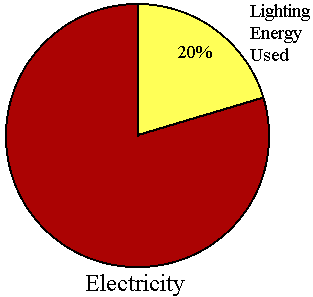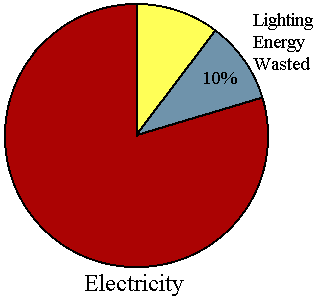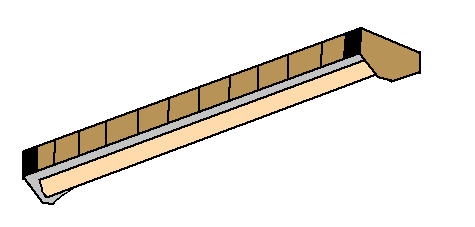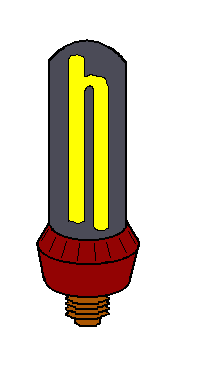TO LIGHT OR NOT TO LIGHT
- GOAL:
- The student will recognize the need to reduce energy waste through proper lighting.
- OBJECTIVES:
- The student will be able to:
- 1. Explain the extent of energy waste through improper lighting.
- 2. Compare incandescent and fluorescent lighting systems.
- 3. List ways to help reduce lighting costs.
- LESSON/INFORMATION:
- About 20% of all electricity produced in the United States is used for lighting. Unfortunately, about half of this energy is wasted by inefficient lighting sources or careless consumers.


- While lighting represents only about 5% of the consumer's energy budget, this cost can possibly be cut in half by following more energy conscious lighting practices.
- Activity 1:
- If a family's average monthly utility bill is $90,
- a. How much is spent on lighting monthly? __________
- b. How much is spent on lighting annually? __________
- c. How much could this family save annually by following more energy conscious lighting practices? __________
- What was your utility bill last month?__________
- How much did your family spend on lighting?__________
- Light bulbs are sold by wattage. The higher the wattage, the more energy needed to operate that bulb. Actual visible light produced is measured in lumens. A lumen refers to the amount of visible light produced per watt.
- Bulb efficiency can be measured by how much visible light is produced per watt, or in lumens per watt. This information is found on the light bulb package. Therefore, it is best for the consumer to purchase bulbs with the highest lumen output per watt.
- Incandescent Lighting:
- Most homes today are lighted with incandescent bulbs. This is not an efficient form of lighting since 90% of the energy used by the incandescent bulb is given off as heat, and only 10% of the energy is used to give off light.

- There are ways, however, to reduce energy waste with incandescent bulbs. These include:
- Using bulbs of lower wattage whenever possible.
- Using bulbs with a higher lumen output per watt.
- Using one large bulb rather than several small ones.
- Focusing light close to work areas.
- Keeping light bulbs and fixtures clean.
- Turning off lights if leaving the room for more than 10 minutes.
- Dimmer switches can also be used with incandescent bulbs. Solid-state dimmers now on the market can save up to 50% of lighting energy used and cost only about $4 per unit. The older type dimmer did not save energy for it varied light availability by converting energy into heat.
- Dimmers are best used in areas where lighting needs vary. For example, a 100-watt bulb may be needed over the dining table for two hours a day while children do their homework. When the room is used for other purposes, however, dimming the light to 60 watts may provide adequate lighting.
- Fluorescent Lighting:
- Another type of lighting, fluorescent lighting, has been found to be much more energy efficient. Fluorescent lights give out 4 times as much light per watt as incandescent bulbs. They also last up to 20 times longer!!

- Fluorescent lighting can be made even more efficient by the use of reflectors and low energy ballasts. When using an aluminum lining inside fluorescent fixtures, up to 35% more light is reflected downward for use.
- While fluorescent lighting has been more common in the workplace, it is now being seen more often in the home. For consumers who want to save energy and energy dollars on lighting but already have incandescent fixtures in the home, there is an answer!!
- Compact fluorescent bulbs are available in a screw-in base that fits into conventional incandescent fixtures. These bulbs vary from 5 to 18 watts and produce up to four times as much light per watt as conventional bulbs. Thus, these bulbs provide more lumens or visible light, for less wattage or energy cost.

- Daylighting or natural lighting is usually also very efficient. However, the light usually needs to be shaded as heat will enter the building along with the light.
- Activity 2:
- Examine the rooms in your home and tell what type of lighting is found in each (lamps, bulbs, wattage, etc.):
- Kitchen:____________________________________________________
- ____________________________________________________________
- Living Room:________________________________________________
- ____________________________________________________________
- Bedrooms:___________________________________________________
- ____________________________________________________________
- For the information you just learned, what can you and your family do to cut down your lighting costs?
- 1.
- 2.
- 3.
- RESOURCES:
- Governor's Energy Office. The Facts of Light: Save it, Florida. Tallahassee, Florida: Governor's Energy Office, 1986.
- U.S. Department of Energy. Information: Energy Efficient Lighting. FS 141, Second Edition.
- INFORMATION CHECK
- Place a "T" in front of the following statements that are true and an "F" in front of the following statements that are false. Under each false statement, explain why it is false.
- _____1. Only about 5% of electricity produced in the U.S. is used for lighting.
- _____2. Only about 5% of the average household's total energy budget is spent on lighting.
- _____3. If a family's total monthly energy budget is $150, about $15 is used for lighting.
- _____4. The term lumen refers to actual visible light produced.
- _____5. Two 60-watt bulbs will always produce more lumens than one 100-watt bulb, as actual light produced relies much more on wattage than on lumens.
- _____6. Incandescent bulbs produce more heat than light.
- _____7. Dust on incandescent bulbs and fixtures does not affect the amount of light available for use.
- _____8. It is better to use three 60-watt bulbs in your lamp instead of one large 150-watt bulb.
- _____9. About 50% of the energy used by incandescent bulbs goes into producing light.
- _____10. When leaving the room for only 2 to 3 minutes, it will still save energy to turn off incandescent bulbs.
- _____11. Fluorescent bulbs use electricity more efficiently than incandescent bulbs and produce about four times as much light per watt.
- _____12. Although fluorescent bulbs are more efficient, they do not last as long as incandescent bulbs.
- _____13. It is not possible to add fluorescent lighting to your home without totally rewiring the existing fixtures.
- _____14. Older dimmer switches save more energy than the new solid-state dimmer switches on the market today.
- _____15. Reflectors in fluorescent lights are a good investment as they reflect up to 35% more light downward towards the task at hand.
- TEACHER'S NOTES
- ACTIVITY 1:
- If a family's average monthly utility bill is $90
- a. How much is spent on lighting monthly? $4.50
- b. How much is spent on lighting annually? $54.00
- c. How much could this family save annually by following more energy conscious lighting practices? $27.00
- Check students calculations regarding their own utility bills.
- ACTIVITY 2:
- Check to see that student has explained the type of lighting in each room of the home. Information should include:
- - Wall or ceiling fixtures?
- - How many bulbs used?
- - Incandescent or fluorescent?
- - Total wattage?
- - Number of lamps?
- - Placement in the room?
- Suggestions for improvement should include items such as:
- - Remove some bulbs or use bulbs of lower wattage.
- - Use one large lamp or bulb instead of many small ones.
- - Try to use adapters and fluorescent bulbs in some fixtures.
- - Place lights closer to work areas.
- - Clean bulbs and fixtures.
- - Turn lights off when not in use.
- DEFINITIONS:
- 1. Fluorescent bulbs -
- These bulbs convert electric power to light by using an electric charge to excite gases in the bulb. Thus the electricity is going more directly to produce light instead of heat.
- 2. Incandescent bulbs -
- These bulbs use electricity to heat a tungsten filament in a vacuum until the filament glows. Thus electricity is used to produce heat. The light is from the glow of the filament.
- 3. Lumens -
- The measure of how much visible light is produced. Efficient light bulbs produce more lumens per watt -- more visible light is produced per watt of electricity.
- 4. Watt -
- The measure of input of electrical power. The higher the wattage of the bulb, the more electricity it uses.
- ANSWERS TO INFORMATION CHECK:
- 1. False - About 20% of electricity in the U.S. goes to produce light.
- 2. True
- 3. False - This family would spend $7.50 per month on lighting.
- 4. True
- 5. False - Actual light depends more on lumens than wattage.
- 6. True
- 7. False - Dust does reduce light available in the room; cleaning bulbs and fixtures does save energy.
- 8. False - One large bulb is more efficient than several small ones. Here also, the 150-watt bulb would use less electricity than the total of 180 watts from the three 60-watt bulbs.
- 9. False - Only 10% of the energy used by incandescent bulbs goes to producing light.
- 10. False - Leave lights on unless you will be out of the room more than 10 minutes.
- 11. True
- 12. False - Fluorescent bulbs last up to 20 times longer than incandescent bulbs.
- 13. False - There are adapters and specialized bulbs on the market that allow fluorescent bulbs to be used in existing incandescent fixtures.
- 14. False - Older dimmers turned light energy into heat; energy was not conserved.
- 15. True
Comments or questions to: TechAsmt@LA.GOV
Return to Home Energy Menu






